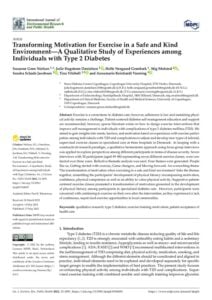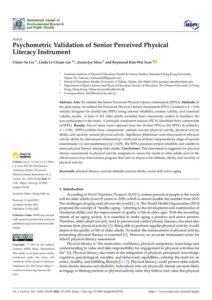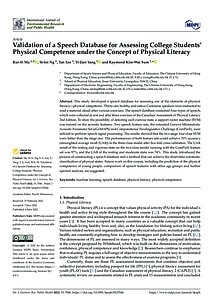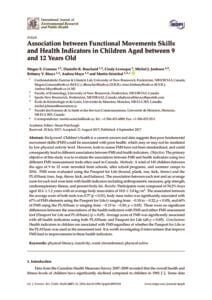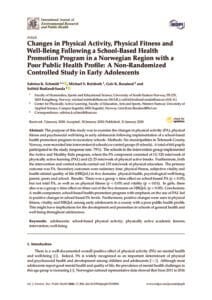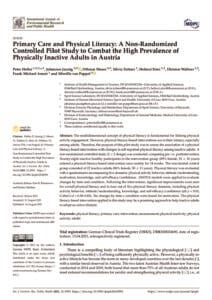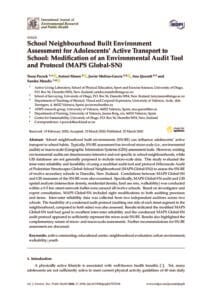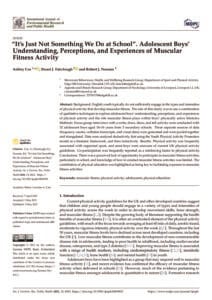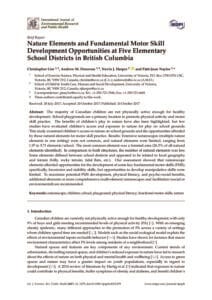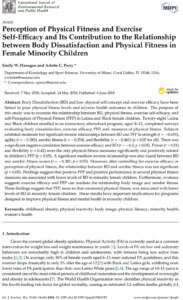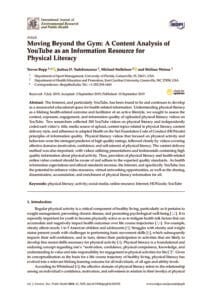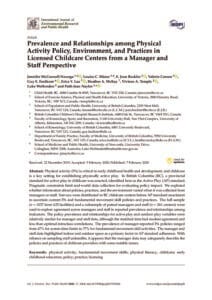-
Transforming Motivation for Exercise in a Safe and Kind Environment
Abstract – Transforming Motivation for Exercise in a Safe and Kind Environment – A Qualitative Study of Experiences among Individuals with Type 2 Diabetes Exercise… -
Psychometric Validation of Senior Perceived Physical Literacy Instrument
Abstract Aim: To validate the Senior Perceived Physical Literacy Instrument (SPPLI). Methods: In the pilot study, we refined the Perceived Physical Literacy Instrument (PPLI, Cronbach’s α =… -
Validation of a Speech Database for Assessing College Students’ Physical Competence under the Concept of Physical Literacy
Abstract This study developed a speech database for assessing one of the elements of physical literacy—physical competence. Thirty-one healthy and native Cantonese speakers were instructed… -
Association between Functional Movements Skills and Health Indicators in Children Aged between 9 and 12 Years Old
Background Children’s health is a current concern and data suggests that poor fundamental movement skills (FMS) could be associated with poor health, which may or… -
Changes in Physical Activity, Physical Fitness and Well-Being Following a School-Based Health Promotion Program in a Norwegian Region with a Poor Public Health Profile: A Non-Randomized Controlled Study in Early Adolescents
Purpose: The purpose of this study was to examine the changes in physical activity (PA), physical fitness and psychosocial well-being in early adolescents following implementation… -
Primary Care and Physical Literacy: A Non-Randomized Controlled Pilot Study to Combat the High Prevalence of Physically Inactive Adults in Austria
Abstract The multidimensional concept of physical literacy is fundamental for lifelong physical activity engagement. However, physical literacy-based interventions are in their infancy, especially among adults.… -
School Neighbourhood Built Environment Assessment for Adolescents’ Active Transport to School: Modification of an Environmental Audit Tool and Protocol (MAPS Global-SN)
Abstract School neighbourhood built environments (SN-BE) can influence adolescents’ active transport to school habits. Typically, SN-BE assessment has involved micro-scale (i.e., environmental audits) or macro-scale… -
“It’s Just Not Something We Do at School”. Adolescent Boys’ Understanding, Perceptions, and Experiences of Muscular Fitness Activity
Background English youth typically do not sufficiently engage in the types and intensities of physical activity that develop muscular fitness. The aim of this study… -
Nature Elements and Fundamental Motor Skill Development Opportunities at Five Elementary School Districts in British Columbia
Abstract The majority of Canadian children are not physically active enough for healthy development. School playgrounds are a primary location to promote physical activity and… -
Perception of Physical Fitness and Exercise Self-Efficacy and Its Contribution to the Relationship between Body Dissatisfaction and Physical Fitness in Female Minority Children
Abstract: Body Dissatisfaction (BD) and low physical self-concept and exercise efficacy have been linked to poor physical fitness levels and adverse health outcomes in children.… -
Moving Beyond the Gym: A Content Analysis of YouTube as an Information Resource for Physical Literacy
Abstract The Internet, and particularly YouTube, has been found to be and continues to develop as a resourceful educational space for health-related information. Understanding physical… -
Prevalence and Relationships among Physical Activity Policy, Environment, and Practices in Licensed Childcare Centers from a Manager and Staff Perspective
Abstract Physical activity (PA) is critical to early childhood health and development, and childcare is a key setting for establishing physically active play. In British…


